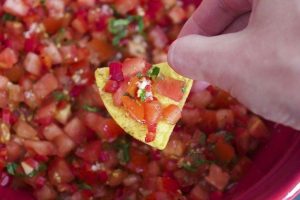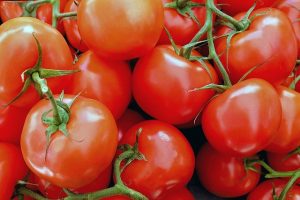 Summer is great time for salsa and chips. Tomatoes and peppers are fresh at the market or in the garden. During these months we all enjoy making salsa and sharing it with friends and family at gatherings. We can also preserve this summer feeling to enjoy throughout the rest of the year.
Summer is great time for salsa and chips. Tomatoes and peppers are fresh at the market or in the garden. During these months we all enjoy making salsa and sharing it with friends and family at gatherings. We can also preserve this summer feeling to enjoy throughout the rest of the year.
Basics for Canning Salsa
There are a few basics that we all need to remember when we want to preserve salsa.
- Follow a tested recipe for canning salsa.
- Choose ripe ingredients
- Use the proper acidity for the recipe
- 5% Vinegar
- Commercially bottled Lemon or Lime Juice
- Gather canning equipment
Using a tested recipe
Many people have a fresh salsa recipe that they enjoy. However, a recipe does not translate into being able to preserve the salsa for use later in the winter, unless you are willing to freeze it. Some sources for a tested recipe are National Center for Home Food Preservation, Preserve Smart, and CSU fact sheet Canning Tomatoes and Tomato Products. My favorite recipe is the Chili Salsa with the weights listed. This allows me to go to farmer’s markets to purchase my produce without guessing how much I need.
Ingredients
Salsa can be a fun way to preserve peak-of-season tomatoes and peppers.
Tomatoes
 Tomatoes are the main ingredient in most salsas. Choose ripe, undamaged tomatoes. Avoid over-ripe tomatoes, or late season tomatoes from dead or frost-killed vines. Paste or Italian tomatoes produce thicker salsas than large slicing tomatoes.
Tomatoes are the main ingredient in most salsas. Choose ripe, undamaged tomatoes. Avoid over-ripe tomatoes, or late season tomatoes from dead or frost-killed vines. Paste or Italian tomatoes produce thicker salsas than large slicing tomatoes.
Tomatillos are also known as Mexican husk tomatoes. Remove the dry outer husk before using them in your recipe. These small fruits have a relatively low pH (~3.8) and a distinct flavor. They are popular in green salsas and may be substituted for red tomatoes in tested salsa recipes.
Peppers
Use only high-quality peppers. Do not increase peppers in any recipe; but you may  substitute one type of pepper for another. Peppers come in a wide variety of colors. Almost all varieties turn from green to yellow, orange, red or purple when they are fully ripe. Green peppers are often harvested before they are ripe, and they are often less expensive in the store because they can better withstand transport and last longer once in storage.
substitute one type of pepper for another. Peppers come in a wide variety of colors. Almost all varieties turn from green to yellow, orange, red or purple when they are fully ripe. Green peppers are often harvested before they are ripe, and they are often less expensive in the store because they can better withstand transport and last longer once in storage.
Peppers vary in flavor from ripe red bell peppers that are almost sweet, to fiery hot Thai or habanero varieties. The heat of peppers is not tied to acidity; both sweet and hot peppers are low in acid. The heat of peppers is measured in Scoville units. In the early 1900’s Wilbur Scoville extracted capsaicin from different types of peppers. He recruited volunteers to taste the capsaicin samples and assigned a rating to each based on the amount of water required to neutralize the hotness. The common bell pepper has a Scoville unit of 0; while tiny Thai peppers have Scoville units of 50,000 or 100,000. In comparison, jalapeno peppers popular in salsa have a Scoville heat of 2,500 to 5,000 units. The heat of peppers is now measured in the laboratory, but the tradition lives on.
Other Ingredients
Other popular ingredients in traditional salsas are onions, garlic, acid, and spices.
 In addition to peppers, onions and garlic are primary low-acid ingredients that are added to salsas. Never add more low-acid ingredients than is specified in the recipe. Adding acid is necessary to safely preserve salsa because the natural acidity may not be high enough to prevent growth of Clostridium botulinum. Follow recipe directions for adding vinegar (5% acetic acid) or bottled lemon or lime juice to home canned salsa. Commercially bottled lemon or lime juice is more acidic than vinegar, so lemon or lime juice CAN be substituted for vinegar in recipes.
In addition to peppers, onions and garlic are primary low-acid ingredients that are added to salsas. Never add more low-acid ingredients than is specified in the recipe. Adding acid is necessary to safely preserve salsa because the natural acidity may not be high enough to prevent growth of Clostridium botulinum. Follow recipe directions for adding vinegar (5% acetic acid) or bottled lemon or lime juice to home canned salsa. Commercially bottled lemon or lime juice is more acidic than vinegar, so lemon or lime juice CAN be substituted for vinegar in recipes.
Spices and herbs add characteristic flavor to salsas. You may decrease the amount of spices and herbs, but do not significantly increase the amounts before canning. Remember that powdered spices will slightly cloud the liquid, but this is rarely a problem with salsas. For best flavor, consider omitting herbs such as cilantro and parsley in salsa that will be canned; and then add these herbs fresh to salsa before serving.

